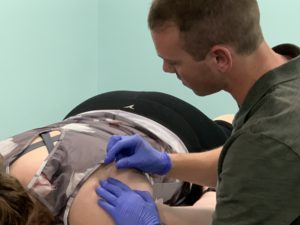Dry needling is a treatment involving a thin needle, used to target a painful trigger point. A physical therapist feels for the trigger point and then inserts the needle. The needle helps to release the tightness, stimulate blood flow, and promote relaxation to the aggravated muscle. Dry needling is one possible treatment option to be used in conjunction with massage, exercise, heat/ice to help manage pain. Results can vary from person to person and can range from very short term (hours-days) to more permanent effects. A physical therapist in the state of Maryland receives special education after physical therapy school to receive a certification in dry needling. At Harbor Physical Therapy, Dr. David Reymann is a certified myofascial trigger point therapist. If you are interested in trying dry needling or learning more about it, give Harbor Physical Therapy a call at 443-524-0442. 
Month: November 2019
How to Prevent Back Pain with Household Chores
If a household chore is not done with proper biomechanics, you are more likely to strain you back muscles resulting in pain. Lots of household chores are repetitive so it is a good rule of thumb to use both the right and left side of your body equally to avoid an overuse injury. Check out the tips below highlighting some specific household chores and body positioning that will decrease strain on your back muscles.
- Washing dishes– to decrease back strain at the sink, open the base cabinet and put your foot up on the ledge to become closer to the sink.
- Vacuuming– Walk with the vacuum or lunge forward onto one foot keeping your back straight, rather than bending forward with each push of the vacuum.
- Making the bed– Put one knee down on the bed when fastening a sheet to the corner of the mattress or squat to fasten it.
- Grooming– Put one hand down on the counter in the bathroom while using the other to brush your teeth or shave. Also, you can put a foot up onto the ledge of the base cabinet as in the kitchen.
